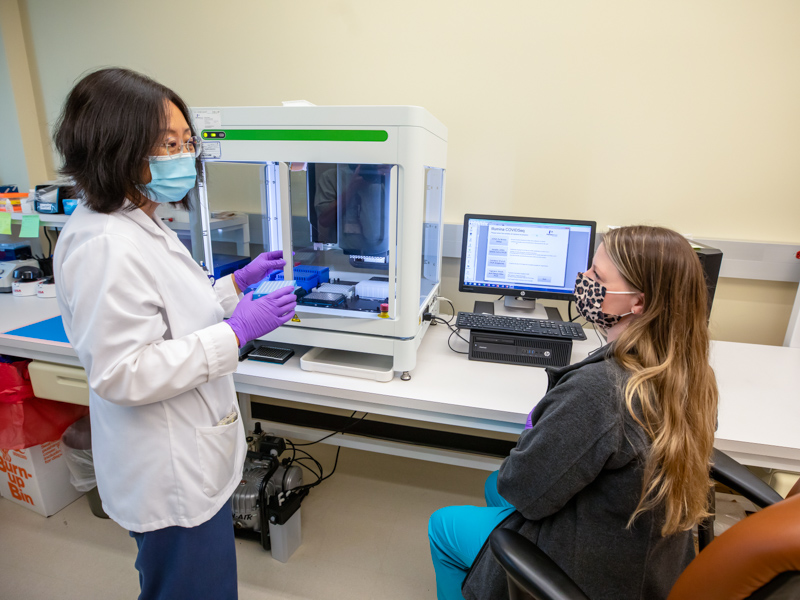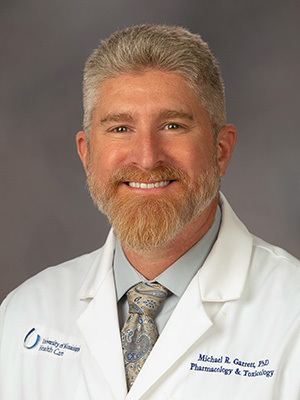Omicron’s “surprises” spur scientific interest

The University of Mississippi Medical Center hasn’t found a case of the latest COVID-19 variant of concern yet, but its scientists have their eyes open for Omicron.
Also called B.1.1.529, Omicron makes up less than 0.1 percent of cases recorded in the Centers for Disease Control and Prevention’s variant data tracker.The Mississippi State Department of Health announced its first confirmed case December 6.
UMMC’s Molecular and Genomics Core Facility plays a major role in the state’s SARS-CoV-2 variant surveillance. Supported by MSDH and CDC funding, they have sequenced full viral genomes from more than 5,400 COVID-19 cases in the state since March.
The genome is the instruction guide for life. DNA in most organisms and RNA in viruses like SARS-CoV-2, this chain of tiny chemicals called nucleotides tells an organism how to run, repair, and reproduce itself. Scientists can look at the sequence of nucleotides to learn if virus samples come from different species or, if from the same species, their degree of relatedness.
The MSDH is currently asking labs to send COVID-positive samples from patients who recently travelled to locations with Omicron cases to the Mississippi Public Health Laboratory for sequencing. That includes South Africa, where scientists first identified the variant. Mississippi’s Omicron case did not come from UMMC.
Dr. Ashley Robinson, associate director of the MGCF and professor of microbiology and immunology, said UMMC has produced most of Mississippi’s 8,100 viral genomes that are in sequence databases so far. Many come from the Delta variant, which caused the state’s highest peak in COVID-19 cases and deaths. It is still the predominant form of the virus in Mississippi and worldwide.

“At the peak of the Delta wave we were sequencing samples from 169 cities and 72 counties in Mississippi, so the geographic reach of the surveillance system nicely covered the state,” Robinson said. “If Omicron was introduced into a small community in Mississippi and began spreading, there's a good chance it would eventually show up in our weekly surveillance.”
Because new confirmed COVID-19 cases are relatively low, the MGCF is sequencing most of the available UMMC patient samples. This makes it likely the team will quickly identify Omicron cases that come to the Medical Center.
Omicron has “several surprises” that distinguish it from the previous variants, Robinson said.
It has at least 50 differences in its genome compared to the original SARS-CoV-2 viruses circulating in early 2020. About 30 of Omicron’s differences occur in the spike protein. This protein helps the virus enter cells so it can replicate. It’s also the target of monoclonal antibody treatments and the design basis for vaccines. Robinson says we don’t know yet if those spike protein changes will change the effectiveness of those innovations against Omicron.
Omicron’s genome suggests that it is a descendant of viruses close to the trunk of the SARS-CoV-2 family tree, a bit like grandparents producing a new child of their own.
That’s noteworthy because “this next variant of concern did not arise from Delta, which has been the dominant strain for about 6 months,” Robinson said.
The last observation is that Omicron is “outcompeting the predominant Delta strains in South Africa,” he said. He notes that other non-Delta variants, like Lambda and Mu, were unable to outcompete Delta in Mississippi. He says it’s likely Omicron has a higher reproductive rate and is more contagious than Delta.
However, Omicron might not become the primary cause of COVID-19 infections in all regions. There are about 100 Delta sub-types, and the ones common in South Africa aren’t the same as those in Mississippi.
“In infectious agents, there’s typically a trade-off between transmissibility and virulence,” Robinson said, and there’s reason to be “hopeful” Omicron follows this pattern. Early data from South Africa suggest it causes less severe disease than Delta.

Dr. Michael Garrett, director of the MCGF and professor of pharmacology and toxicology, says there is a one-week lag between COVID-positive samples entering the UMMC lab and their inclusion in MSDH’s variant reporting. Therefore, it will take several days for any Omicron case at the Medical Center to show up in the data.
“The MSDH and CDC funding allowed our team to be responsive to the Delta wave,” Garrett said. This funding and institutional support provided new equipment that helped the MGCF process nearly 300 samples a week at its peak.
If Omicron becomes part of another wave, Garrett said, “the lab has the capacity we need to prepare for another increase in cases.”

